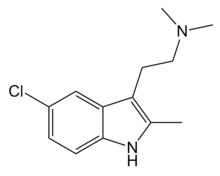ST-1936
ST-1936 (2-methyl-5-chloro-N,N-dimethyltryptamine) is a tryptamine derivative which is used in scientific research. It acts as a selective 5-HT6 receptor agonist, with a Ki of 13 nM, and much weaker action at 5-HT2B and 5-HT7 subtypes. In animal studies it has been found to increase dopamine and noradrenaline mediated signalling but decreases glutamatergic transmission, and has antidepressant effects.[1][2][3][4]
 | |
| Clinical data | |
|---|---|
| ATC code |
|
| Identifiers | |
IUPAC name
| |
| CAS Number | |
| PubChem CID | |
| ChemSpider | |
| Chemical and physical data | |
| Formula | C13H17ClN2 |
| Molar mass | 236.74 g/mol g·mol−1 |
| 3D model (JSmol) | |
SMILES
| |
InChI
| |
See also
- EMD-386,088
- EMDT
- 5-Bromo-DMT
- 5-Chloro-AMT
References
- Valentini, V.; Frau, R.; Bordi, F.; Borsini, F.; Di Chiara, G. (2011). "A microdialysis study of ST1936, a novel 5-HT6 receptor agonist". Neuropharmacology. 60 (4): 602–608. doi:10.1016/j.neuropharm.2010.12.006. PMID 21185318.
- Riccioni, T.; Bordi, F.; Minetti, P.; Spadoni, G.; Yun, H. M.; Im, B. H.; Tarzia, G.; Rhim, H.; Borsini, F. (2011). "ST1936 stimulates cAMP, Ca2+, ERK1/2 and Fyn kinase through a full activation of cloned human 5-HT6 receptors". European Journal of Pharmacology. 661 (1–3): 8–14. doi:10.1016/j.ejphar.2011.04.028. PMID 21549693.
- Tassone, A.; Madeo, G.; Schirinzi, T.; Vita, D.; Puglisi, F.; Ponterio, G.; Borsini, F.; Pisani, A.; Bonsi, P. (2011). "Activation of 5-HT6 receptors inhibits corticostriatal glutamatergic transmission". Neuropharmacology. 61 (4): 632–637. doi:10.1016/j.neuropharm.2011.05.004. PMID 21619890.
- Scheggi, S.; Marchese, G.; Borsini, F.; Bordi, F.; De Montis, M. G. (2011). "Effects of the 5-HT6 receptor agonist ST 1936 on depression- and anhedonia-like experimental models". Behavioural Brain Research. 224 (1): 35–43. doi:10.1016/j.bbr.2011.05.019. PMID 21645553.
|
This article is issued from
Wikipedia.
The text is licensed under Creative
Commons - Attribution - Sharealike.
Additional terms may apply for the media files.